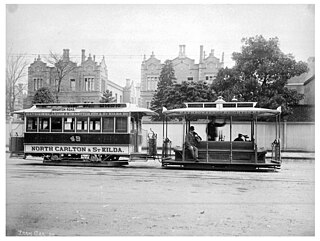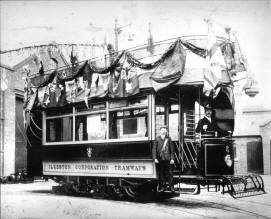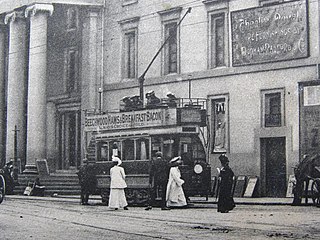Related Research Articles

The Melbourne cable tramway system was a cable car public transport system, which operated between 1885 and 1940 in Melbourne, Victoria, Australia.

The Sydney tramway network served the inner suburbs of Sydney, Australia from 1879 until 1961. In its heyday, it was the largest in Australia, the second largest in the Commonwealth of Nations, and one of the largest in the world. The network was heavily worked, with about 1,600 cars in service at any one time at its peak during the 1930s . Patronage peaked in 1945 at 405 million passenger journeys. Its maximum street trackage totalled 291 km in 1923.

Nottingham and District Tramways Company Limited was a tramway operator from 1875 to 1897 based in Nottingham in the United Kingdom.

The Kingston upon Hull tramway network was a network of 4 ft 8 1⁄2 instandard gauge tram lines following the five main roads radially out of the city centre of Kingston upon Hull, East Riding of Yorkshire, England. Two of these lines went west, and two east. The fifth went to the north, and branched to include extra lines serving suburban areas. Additionally a short line linked the city centre to the Corporation Pier where a ferry crossed the Humber Estuary to New Holland, Lincolnshire.

Ilkeston Corporation Tramways was a tramway network in Ilkeston, Derbyshire, in the East Midlands of England run firstly by Ilkeston Borough Council and from 1916 by the Nottinghamshire and Derbyshire Tramways Company. The system ran between 1903 and 1931. Ilkeston was the first town in Derbyshire to adopt and operate a fully electrical tramway system.

Warrington Corporation Tramways was the owner and operator of an electric tramway system in the early 20th century serving the town of Warrington, at the time a county borough of Lancashire, England.
Dover Corporation Tramways was the operator of the second tramway system built in the United Kingdom. It was in operation from 1897 to 1936. The worst ever tram accident in the United Kingdom occurred on the system in 1917.
Lowestoft Corporation Tramways was the operator of the electric tramway system that served Lowestoft from 22 July 1903 until 8 May 1931.

Norwich Electric Tramways served the city of Norwich in Norfolk from 30 July 1900 until 10 December 1935.

Ipswich Corporation Tramways was an electric tramway system that served the town of Ipswich in Suffolk from 23 November 1903 until 26 July 1926.

Luton Corporation Tramways served the town of Luton in Bedfordshire from 21 February 1908 until 16 April 1932.
Southend-on-Sea Corporation Tramways served the town of Southend-on-Sea in Essex from 19 July 1901 until 8 April 1942.

Bournemouth Corporation Tramways served the town of Bournemouth in Dorset from 23 July 1902 until 8 April 1936.

The City of Oxford and District Tramway Company and its successor the City of Oxford Electric Traction Company operated a horse-drawn passenger tramway service in Oxford between 1881 and 1914. The tramway was unusual for having a track gauge of only 4 feet (1.219 m).

The tramways in Plymouth were originally constructed as four independent networks operated by three different companies to serve the adjacent towns of Plymouth, Stonehouse and Devonport in Devon, England. The merger of the 'Three Towns' into the new borough of Plymouth in 1914 was the catalyst for the three companies to join up under the auspices of the new Plymouth Corporation. The network was closed in 1945, partly as a result of bomb damage during World War II.
Cleveland Street electric railway station was the fifth of five calling points on the 1 1⁄4 miles (2.0 km) eastern, "street" section of the inter-urban Grimsby and Immingham Electric Railway when travelling from Corporation Bridge, Grimsby to Immingham Dock.
Stortford Street electric railway station was the fourth of five calling points on the 1 1⁄4 miles (2.0 km) eastern, "street" section of the inter-urban Grimsby and Immingham Electric Railway when travelling from Corporation Bridge, Grimsby to Immingham Dock.
Jackson Street electric railway station was the second of five calling points on the 1 1⁄4 miles (2.0 km) eastern, "street" section of the inter-urban Grimsby and Immingham Electric Railway when travelling from Corporation Bridge, Grimsby to Immingham Dock.
Yarborough Street electric railway station was the first of five calling points on the 1 1⁄4 miles (2.0 km) eastern, "street" section of the inter-urban Grimsby and Immingham Electric Railway when travelling from Corporation Bridge, Grimsby to Immingham Dock.
The Melbourne tram network began in 1884 with the construction of the Fairfield Horse Tramway. However, the purpose of the line was to increase land prices in the area, and it soon closed during the depression in 1890. The first genuine attempt to construct a tramway network was the construction of the Richmond cable tram line by the Melbourne Tramway & Omnibus Company in 1885. Over the next few years, 16 more cable tram lines were constructed, as well as numerous other horse tramways. The depression of the early 1890s slowed further expansion of the cable network. The first electric tram line was the Box Hill and Doncaster tramway which opened in 1889. This was a pioneering line in what was then the countryside and thus didn't receive much patronage. It closed in 1896. The next attempt at an electric tramway was Victorian Railways' St Kilda to Brighton line, which opened in 1906. Later that year, the North Melbourne Electric Tramway and Lighting Company opened lines to Essendon and Maribyrnong. Many local councils formed their own tramway trusts and built tramways within their own constituency. The most successful of these was the Prahran and Malvern Tramway Trust.
References
- 1 2 Turner, Keith (1996). The Directory of British Tramways. Patrick Stephens Ltd. ISBN 1-85260-549-9.